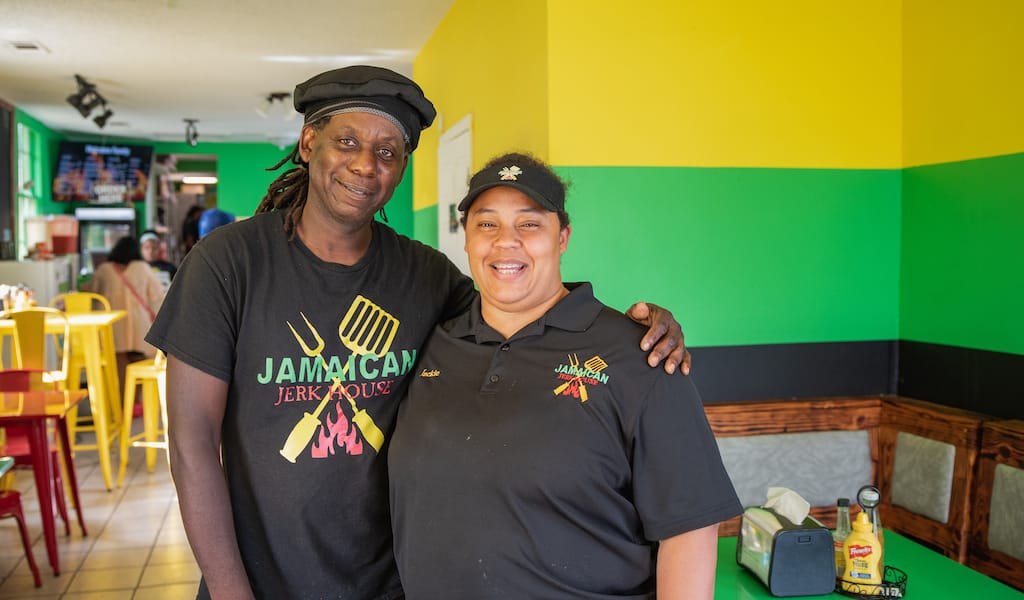New Orleans is arguably one of the most Afro-Caribbean cities in the United States. In the minds of some, we don’t even qualify as a US city, but rather the northernmost outpost of the Caribbean. From our architecture to our food and our rhythms, we sit apart from the rest of the South. We love spice and deep flavors, cooking that is evocative of people and place. Jamaican food would seem like a natural fit here, and it is, though it is not nearly as commonplace as it should be, all things considered. But Richard Rose and his wife Jackie Diaz are looking to change that with their new Upper 9th Ward restaurant on St. Claude Avenue, Jamaican Jerk House.
The small, canary yellow building with bright green accents that houses Jamaican Jerk House would be easy to miss if you aren’t looking for it. It sits on the opposite side of the St. Claude Avenue neutral ground* from the trendier Bywater neighborhood, which transitioned from a working class, largely Black neighborhood to a gentrified white neighborhood in the years following Katrina. Two flags advertising the restaurant are attached to an old bike rack that sits in front of the building, which itself has the countenance of a private residence. However, when you open the nondescript white door to the space, you are met with bursts of color – red, green, and gold tables and chairs and bright amber walls – and the bouquet of Jamaican cuisine.
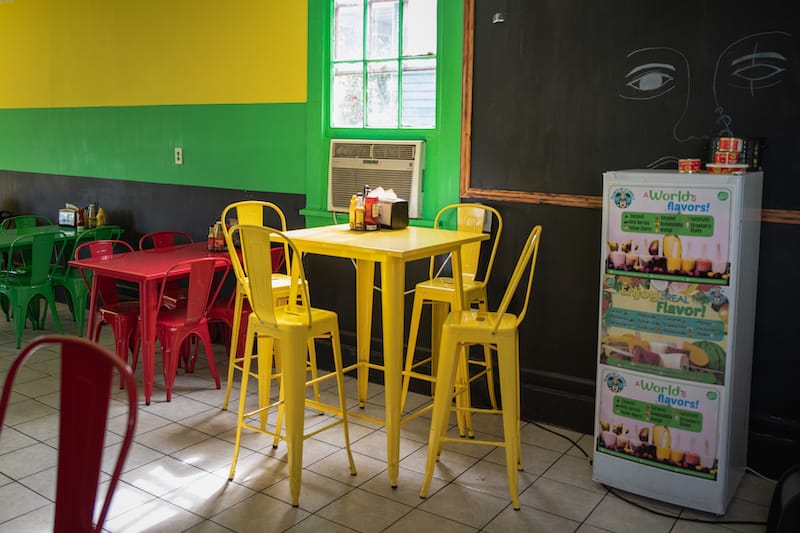
Richard Rose’s route to restauranteur has been circuitous. He arrived in New Orleans from Kingston, Jamaica, fifteen years ago to help rebuild the city following Hurricane Katrina. Soon after, he found himself working at the Marathon Oil Refinery in Reserve, LA. It was there he discovered that oil was not the liquid gold he’d been looking for.
“I used to make my own jerk sauce at home and bring it to the plant and sell it,” said Rose. “Everybody loved the sauce. They said, ‘You shouldn’t be working in the plant – you should open your own restaurant.’”
Rose sold the jerk sauce for $8 a bottle, and people couldn’t get enough of it. During this time, He also met Jackie Diaz, now his wife and business partner. According to Rose, it was Diaz who “pushed” him to share the flavors of his native Kingston with New Orleans. For Diaz, who is of Cuban descent, Rose’s cooking was a revelation.

“At first I was like, ‘What is jerk? Why do they call it jerk?’” Diaz said with a laugh. “But then I tried it and was like ‘Oh my God, Richard. What are you doing? You need to sell this.”
Jerk, for the uninitiated, is specific to both the food and the technique. Jerk cooking begins with a spice rub that typically contains Scotch bonnet peppers, allspice, garlic, thyme, cloves, cinnamon, ginger, scallions, and brown sugar. It’s often made into a wet marinade or paste. It is cooked over an open fire to impart a deep, smoky flavor that compliments the spice. Jerk originated as a cultural exchange between the indigenous Arwak and Taino tribes of Jamaica and enslaved Africans, who shared their culinary knowledge with each other. The word jerk is a derivation of the Spanish charqui, a term for dried meat. The jerk sauce, made from all of the ingredients in the marinade, usually with the addition of soy sauce and lime juice, brings heat, acid and a little sweetness that pairs perfectly with the smoky, spicy meat.
As we stood in the dining room of Jamaican Jerk House, the tall, affable, Rose greeted customers warmly. There were construction workers, nurses, and mothers and fathers and children throughout the small dining room. It was a cross section of working-class New Orleans, a neighborhood joint; the kind that are the backbone of our city. But while the restaurant feels perfectly at home in the 9th ward, the food transports you to the islands.
“Our food is a different food; It is more authentic,” Rose said. “Spicy, flavorful.”
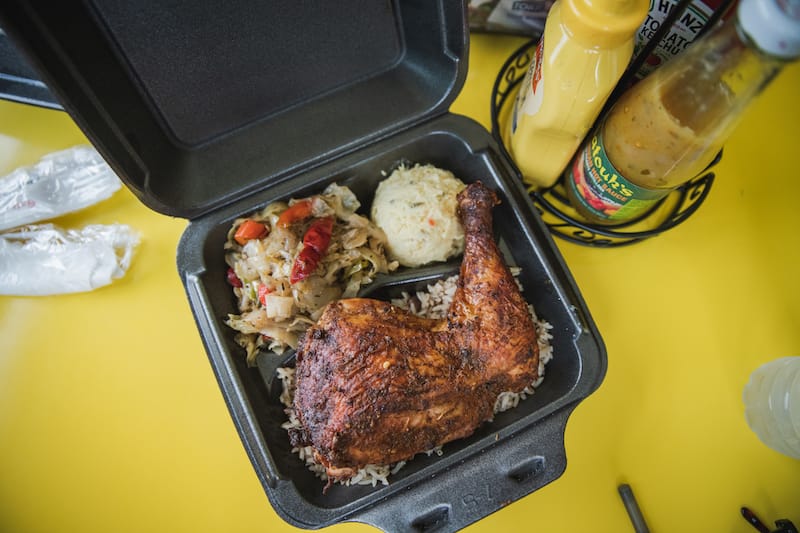
And smoky. Much of the food is cooked outside on the grill, Rose and Diaz explained, which is essential to Jamaican jerk chicken, the house specialty. It is also Rose’s favorite dish, although he laughed and said, “I have so many favorite dishes,” when posed the question, adding, “Everything is nice, but the jerked chicken is really nice.”
Rose also recommended the Jamaican curry, spiked with scotch bonnet peppers that he has imported from Jamaica.
The counterpoint to Rose’s spice is the ebullient Diaz, who subtly weaves aspects of her heritage into the menu through dishes that pay homage to both Cuba and New Orleans. Mofongo Cubano, with its base of mashed plantains, is laced with jerk in a fusion of the Cuban and Jamaican cultures, while the “Cuban” macaroni and cheese, made with spaghetti, is straight out of the 7th ward of New Orleans. And while Diaz says they sometimes get “backlash” for their fusion cuisine from purists, their regular customers love it.
Our food arrived in black to-go boxes, New Orleans corner-store style – dine in and takeout are equally popular here. The boxes, piled high with jerked chicken, jerked beef ribs, fried plantains, macaroni and cheese, potato salad and rice and peas, were reminiscent of both an island escape and a New Orleans church fish fry.
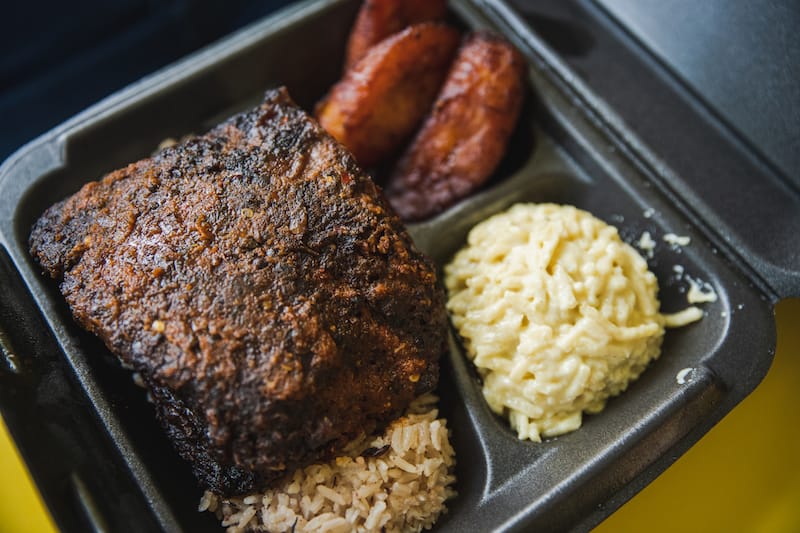
First, we cut into the perfectly cooked jerked chicken leg quarter, which was smoky, succulent and spicy, but not overwhelmingly so, with the heat building gradually with each bite. The fried plantains and rice and peas helped tame the heat, which was augmented by the jerk sauce. Next, we tried the sizable beef rib, which was fork tender, with a deeper smoke but milder heat than the chicken, and just the right ratio of meat to fat.
The plantains, fried and deeply caramelized, recalled the New Orleans classic, Bananas Foster, except in a savory setting. They weren’t overly starchy either. And the mac and cheese, a total outlier that spoke to Diaz’s influence, paired perfectly with the spicier Jamaican fare. We couldn’t stop eating, but the generous portions were easily enough for two meals.
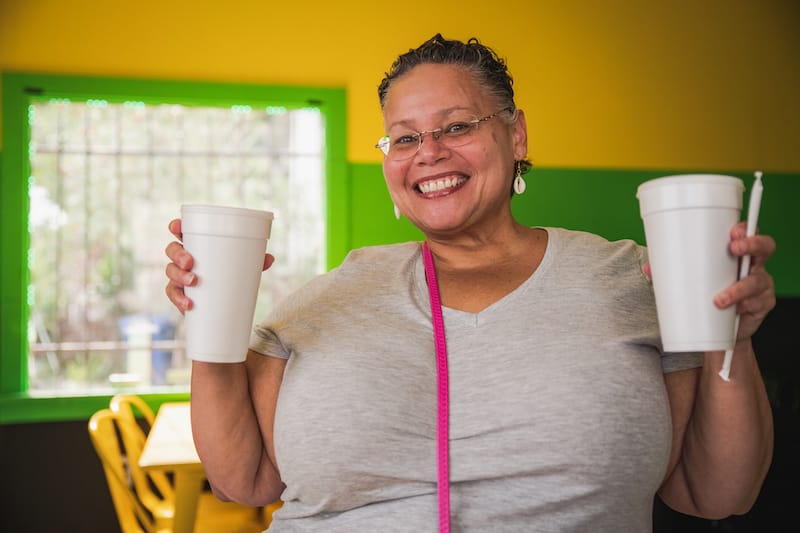
As Rose and Diaz watched a steady stream of customers enter the restaurant, you could see the satisfaction on their faces, as well as the gratitude. They had come a long way, both figuratively and literally, from selling sauce at the plant.
“We never really expected the amount of growth that we are experiencing right now,” said Diaz. “We were kind of scared, petrified [to open the restaurant]…but we knew it was either now or never.”
*The neutral ground is what people outside of New Orleans would call a median. But here, it is a neutral ground, harking back to the early 1800s, post Louisiana Purchase, when the city was divided above and below Canal Street between the French Creoles and the newly arrived Anglo-Americans, neither of whom much cared for one another. The Creoles lived in the French Quarter, while the Anglo-Americans lived in what is now the present-day Central Business District, or CBD. Canal Street divided the two, and the grassy area in the middle was dubbed the neutral ground. Over time, all medians in New Orleans became known as the neutral ground.
 September 7, 2020 Tbilisi Sketches
September 7, 2020 Tbilisi Sketches
Take the plunge into the high-volume hubbub of Tbilisi’s famous Deserter’s Bazaar and […] Posted in Tbilisi November 9, 2018 Jing Teng
November 9, 2018 Jing Teng
Before we got down to the business of food, there was the business of tea. As soon as we […] Posted in Mexico City September 8, 2023 Buriti: Brazil Comes to Barcelona
September 8, 2023 Buriti: Brazil Comes to Barcelona
The buriti, which grows in wet riversides and swamps, is among the most splendid of […] Posted in Barcelona
James CullenJames Cullen
Published on July 15, 2022
Related stories
Sample smoked sulguni & much more with us at the Deserter’s Bazaar.
September 7, 2020
TbilisiTake the plunge into the high-volume hubbub of Tbilisi’s famous Deserter’s Bazaar and you’ll come under a three-senses assault. The piquant aroma from the spice stalls, a butchers’ shouting war and stalls swinging with burgundy-brown, candle-shaped churchkhela sweets. But on one side of the market building, there’s a small slice of calm – in the…
November 9, 2018
Mexico CityBefore we got down to the business of food, there was the business of tea. As soon as we were seated at one of the large round tables at Jing Teng in Mexico City’s Viaducto Piedad neighborhood, our server, Montse, placed a pot of piping hot red tea on the lazy Susan in front of…
September 8, 2023
BarcelonaThe buriti, which grows in wet riversides and swamps, is among the most splendid of South American palms. This tree has special significance in Brazil: it is even an unsuspecting main character in the Brazilian epic novel The Devil to Pay in The Backlands, written by João Guimarães Rosa. For the Guaraní, an indigenous group…







































